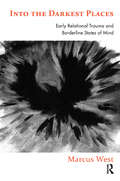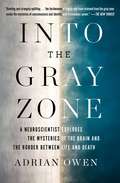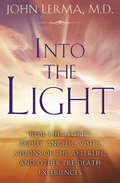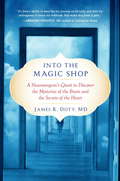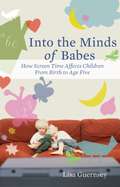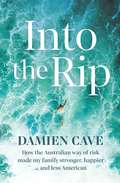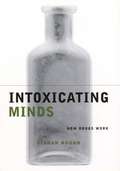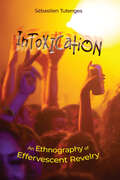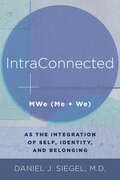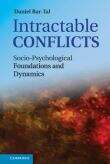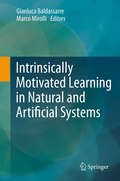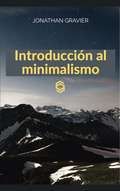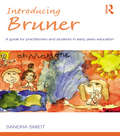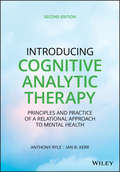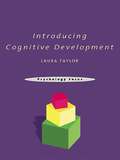- Table View
- List View
Into the Abyss: A neuropsychiatrist's notes on troubled minds
by Prof. Anthony DavidWe cannot know how to fix a problem until we understand its causes. But even for some of the most common mental health problems, specialists argue over whether the answers lie in the person&’s biology, their psychology or their circumstances. As a cognitive neuropsychiatrist, Anthony David brings together many fields of enquiry, from social and cognitive psychology to neurology. The key for each patient might be anything from a traumatic memory to a chemical imbalance, an unhealthy way of thinking or a hidden tumour. Patrick believes he is dead. Jennifer's schizophrenia medication helped with her voices but did it cause Parkinson&’s? Emma is in a coma – or is she just refusing to respond? Drawing from Professor David&’s career as a clinician and academic, these fascinating case studies reveal the unique complexity of the human mind, stretching the limits of our understanding.
Into the Bright Open: A Secret Garden Remix (Remixed Classics #8)
by Cherie DimalineIn the Remixed Classics series, authors from marginalized backgrounds reinterpret classic works through their own cultural lens to subvert the overwhelming cishet, white, and male canon. This queer YA reimagining of The Secret Garden subverts the cishet and white status quo of the original in a tale of family secrets wonderful and horrifying.Mary Lennox didn’t think about death until the day it knocked politely on her bedroom door and invited itself in. When a terrible accident leaves her orphaned at fifteen, she is sent to the wilderness of the Georgian Bay to live with an uncle she's never met.At first the impassive, calculating girl believes this new manor will be just like the one she left in Toronto: cold, isolating, and anything but cheerful, where staff is treated as staff and never like family. But as she slowly allows her heart to open like the first blooms of spring, Mary comes to find that this strange place and its strange people—most of whom are Indigenous—may be what she can finally call home.Then one night Mary discovers Olive, her cousin who has been hidden away in an attic room for years due to a "nervous condition." The girls become fast friends, and Mary wonders why this big-hearted girl is being kept out of sight and fed medicine that only makes her feel sicker. When Olive's domineering stepmother returns to the manor, it soon becomes clear that something sinister is going on.With the help of a charming, intoxicatingly vivacious Metis girl named Sophie, Mary begins digging further into family secrets both wonderful and horrifying to figure out how to free Olive. And some of the answers may lie within the walls of a hidden, overgrown and long-forgotten garden the girls stumble upon while wandering the wilds...The Remixed Classics SeriesA Clash of Steel: A Treasure Island Remix by C.B. LeeSo Many Beginnings: A Little Women Remix by Bethany C. MorrowTravelers Along the Way: A Robin Hood Remix by Aminah Mae SafiWhat Souls Are Made Of: A Wuthering Heights Remix by Tasha SuriSelf-Made Boys: A Great Gatsby Remix by Anna-Marie McLemoreMy Dear Henry: A Jekyll & Hyde Remix by Kalynn BayronTeach the Torches to Burn: A Romeo & Juliet Remix by Caleb RoehrigInto the Bright Open: A Secret Garden Remix by Cherie DimalineMost Ardently: A Pride & Prejudice Remix by Gabe Cole Novoa
Into the Darkest Places: Early Relational Trauma and Borderline States of Mind
by Marcus WestThis book explores the roots of borderline states of mind in early relational trauma and shows how it is possible, and necessary, to visit 'the darkest places' in order to work through these traumas. This is despite the fact that re-experiencing such traumas is unbearable for the patient and they naturally want to enlist the analyst in ensuring that they will never be experienced again. This is the backdrop for the extreme pressures and roles that are constellated in the analysis that can lead to impasse or breakdown of the analytic relationship. The author explores how these areas can be negotiated safely and that, whilst drawing heavily on recent developments in attachment, relational, trauma and infant development theory, an analytic attitude needs to be maintained in order to integrate these experiences and allow the individual to feel, finally, accepted and whole. The book builds on Freud's views of repetition compulsion and re-enactment and develops Jung's concept of the traumatic complex.
Into the Dream Lab: The New Science of Dreams and Nightmares
by Michelle CarrThe science of dreams and nightmares - and their astonishing impact on our waking lives.Dreams slip away when we wake, their remnants jumbled and only half-recalled. Some leave behind surreal sensations or bursts of creativity. Others leave us shaken. But why do we dream at all? How do our bodies interface with our brains while we sleep? Why do some dreams go bad? And how can we harness our sleeping minds to improve our waking lives?Pioneering researcher in sleep medicine Dr Michelle Carr unlocks the science behind the sleeping body. Drawing on her expertise in nightmares, lucid dreaming and the cutting-edge field of dream engineering, she reveals how we can revolutionise our sleeping - and waking - health.Includes an exclusive bonus section with practical techniques for lucid dreaming, nightmare resolution, and dream engineering.
Into the Fire: Troubleshooters 13 (Troubleshooters #13)
by Suzanne BrockmannTroubleshooters: They Never Let You Down. The thirteenth addictive romantic suspense novel in New York Times bestselling author Suzanne Brockmann's Troubleshooters series, filled with thrilling adventure, excitement and passion.Vinh Murphy - former Marine and operative for Troubleshooters Inc. - has been MIA ever since his wife was killed. Murphy blamed the neo-Nazi group the Freedom Network for her death; now their leader Tim Ebersole has been murdered and Murphy is top of the FBI's list of suspects.Murphy himself can't be sure what he did or didn't do during his years of alcohol-induced mourning, but he once again finds himself seeking solace from Hannah Whitfield, the friend who introduced him to his late wife. Learning of Ebersole's murder, Murphy becomes convinced that the Freedom Network has targeted him and Hannah to avenge the death. Faced with the terrifying prospect of losing another woman he loves, Murphy must make the ultimate choice: surrender his life in hopes that Hannah will be spared, or risk everything to salvage their future together.
Into the Gray Zone: A Neuroscientist Explores the Border Between Life and Death
by Adrian OwenIn this &“riveting read, meshing memoir with scientific explication&” (Nature), a world-renowned neuroscientist reveals how he learned to communicate with patients in vegetative or &“gray zone&” states and, more importantly, he explains what those interactions tell us about the working of our own brains.&“Vivid, emotional, and thought-provoking&” (Publishers Weekly), Into the Gray Zone takes readers to the edge of a dazzling, humbling frontier in our understanding of the brain: the so-called &“gray zone&” between full consciousness and brain death. People in this middle place have sustained traumatic brain injuries or are the victims of stroke or degenerative diseases, such as Alzheimer&’s and Parkinson&’s. Many are oblivious to the outside world, and their doctors believe they are incapable of thought. But a sizeable number—as many as twenty percent—are experiencing something different: intact minds adrift deep within damaged brains and bodies. An expert in the field, Adrian Owen led a team that, in 2006, discovered this lost population and made medical history. Scientists, physicians, and philosophers have only just begun to grapple with the implications. Following Owen&’s journey of exciting medical discovery, Into the Gray Zone asks some tough and terrifying questions, such as: What is life like for these patients? What can their families and friends do to help them? What are the ethical implications for religious organizations, politicians, the Right to Die movement, and even insurers? And perhaps most intriguing of all: in defining what a life worth living is, are we too concerned with the physical and not giving enough emphasis to the power of thought? What, truly, defines a satisfying life? &“Strangely uplifting…the testimonies of people who have returned from the gray zone evoke the mysteries of consciousness and identity with tremendous power&” (The New Yorker). This book is about the difference between a brain and a mind, a body and a person. Into the Gray Zone is &“a fascinating memoir…reads like a thriller&” (Mail on Sunday).
Into the Light: Real Life Stories About Angelic Visits, Visions of the Afterlife, and Other Pre-Death Experiences
by John Lerma&“The chronicle of a scientist and humanitarian on a journey of discovery into the mysteries of death and what comes after . . . [a] lovely book.&”— #1 New York Times bestselling author In the groundbreaking book, Dr. John Lerma shares his valuable research on pre-death hallucinations from the countless terminally ill patients he lovingly cares for as a doctor and director at The Medical Center of Houston, Texas. Sixteen inspirational stories chronicle children and adults confronting their deaths through the comforting visions of divine beings. By presenting these mysterious visions, synchronicities, and angelic conversations his patients encounter, Dr. Lerma shows how knowledge of death can ease the pain and fear as we prepare to enter into the light. In this book you will learn: the exhilarating and calming elements of pre-death experiences; healing during the dying process; the difference between hallucinations and visions; and self-forgiveness and self-love as the key to a joyous life and a peaceful transition. The mystical experiences described here delve into the creation of the universe, past and future extinctions, dark angels and white angels, selfless suffering and its effect on humanity, free will as the vital ingredient to create on earth and in heaven, and many more incredible revelations. The poignant stories in Into the Light will leave you feeling uplifted in faith, hope, and love. &“Finally, a science-minded physician has addressed the phenomenon of pre-death experiences with compassion, comprehension, and candor . . . you will be uplifted and inspired by this book.&”—Gary E. Schwartz, PhD, professor of psychology and medicine at the University of Arizona and author of Super Synchronicity
Into the Magic Shop
by James R. DotyExtraordinary things happen when we harness the power of both the brain and the heart Growing up in the high desert of California, Jim Doty was poor, with an alcoholic father and a mother chronically depressed and paralyzed by a stroke. Today he is the director of the Center for Compassion and Altruism Research and Education (CCARE) at Stanford University, of which the Dalai Lama is a founding benefactor. But back then his life was at a dead end until at twelve he wandered into a magic shop looking for a plastic thumb. Instead he met Ruth, a woman who taught him a series of exercises to ease his own suffering and manifest his greatest desires. Her final mandate was that he keep his heart open and teach these techniques to others. She gave him his first glimpse of the unique relationship between the brain and the heart. Doty would go on to put Ruth's practices to work with extraordinary results--power and wealth that he could only imagine as a twelve-year-old, riding his orange Sting-Ray bike. But he neglects Ruth's most important lesson, to keep his heart open, with disastrous results--until he has the opportunity to make a spectacular charitable contribution that will virtually ruin him. Part memoir, part science, part inspiration, and part practical instruction, Into the Magic Shop shows us how we can fundamentally change our lives by first changing our brains and our hearts. From the Hardcover edition.
Into the Magic Shop: A Neurosurgeon's Quest to Discover the Mysteries of the Brain and the Secrets of the Heart
by James R. DotyExtraordinary things happen when we harness the power of both the brain and the heart Growing up in the high desert of California, Jim Doty was poor, with an alcoholic father and a mother chronically depressed and paralyzed by a stroke. Today he is the director of the Center for Compassion and Altruism Research and Education (CCARE) at Stanford University, of which the Dalai Lama is a founding benefactor. But back then his life was at a dead end until at twelve he wandered into a magic shop looking for a plastic thumb. Instead he met Ruth, a woman who taught him a series of exercises to ease his own suffering and manifest his greatest desires. Her final mandate was that he keep his heart open and teach these techniques to others. She gave him his first glimpse of the unique relationship between the brain and the heart. Doty would go on to put Ruth’s practices to work with extraordinary results—power and wealth that he could only imagine as a twelve-year-old, riding his orange Sting-Ray bike. But he neglects Ruth’s most important lesson, to keep his heart open, with disastrous results—until he has the opportunity to make a spectacular charitable contribution that will virtually ruin him. Part memoir, part science, part inspiration, and part practical instruction, Into the Magic Shop shows us how we can fundamentally change our lives by first changing our brains and our hearts.
Into the Magic Shop: A Neurosurgeon's Quest to Discover the Mysteries of the Brain and the Secrets of the Heart
by James R. DotyExtraordinary things happen when we harness the power of both the brain and the heart Growing up in the high desert of California, Jim Doty was poor, with an alcoholic father and a mother chronically depressed and paralyzed by a stroke. Today he is the director of the Center for Compassion and Altruism Research and Education (CCARE) at Stanford University, of which the Dalai Lama is a founding benefactor. But back then his life was at a dead end until at twelve he wandered into a magic shop looking for a plastic thumb. Instead he met Ruth, a woman who taught him a series of exercises to ease his own suffering and manifest his greatest desires. Her final mandate was that he keep his heart open and teach these techniques to others. She gave him his first glimpse of the unique relationship between the brain and the heart. Doty would go on to put Ruth’s practices to work with extraordinary results—power and wealth that he could only imagine as a twelve-year-old, riding his orange Sting-Ray bike. But he neglects Ruth’s most important lesson, to keep his heart open, with disastrous results—until he has the opportunity to make a spectacular charitable contribution that will virtually ruin him. Part memoir, part science, part inspiration, and part practical instruction, Into the Magic Shop shows us how we can fundamentally change our lives by first changing our brains and our hearts.
Into the Minds of Babes: How Screen Time Affects Children from Birth to Age Five
by Lisa GuernseyAs a mother, Lisa Guernsey wondered about the influence of television on her two young daughters. As a reporter, she resolved to find out. What she first encountered was tired advice, sensationalized research claims, and a rather draconian mandate from the American Academy of Pediatrics: no TV at all before the age of two. But like many parents, she wanted straight answers and realistic advice, so she kept digging: she visited infant-perception labs and child development centers around the country. She interviewed scores of parents, psychologists, cognitive scientists, and media researchers, as well as programming executives at Noggin, Disney, Nickelodeon, Sesame Workshop, and PBS. Much of what she found flies in the face of conventional wisdom and led her to conclude that new parents will be best served by focusing on “the three C’s”: content, context, and the individual child. Advocating a new approach to television and DVDs, Guernsey focuses on infants to five-year-olds and goes beyond the headlines to explore what exactly is “educational” about educational media. She examines how play and language development are affected by background and foreground television and how to choose videos that are age-appropriate. She explains how to avoid the hype of “brain stimulation” and focus instead on social relationships and the building blocks of language and literacy. Along the way, Guernsey highlights independent research on shows ranging from Dora the Explorer to Dragon Tales, and distills some surprising new findings in the field of child development. Into the Minds of Babesis a fascinating book that points out how little credible research exists to support the AAP’s dire recommendation. Parents, teachers, and psychologists will be relieved to learn positive approaches to using videos with young children and will be empowered to make their own informed choices.
Into the Rip: How the Australian Way of Risk Made My Family Stronger, Happier ... and Less American
by Damien CaveWhen Damien Cave brought his young family to Sydney to set up the New York Times&’ Australian Bureau, they encountered the local pursuits of Nippers and surfing – and a completely different approach to risk that changed the way they lived their lives. Damien Cave has always been fascinated by risk. Having covered the war in Iraq and moved to Mexico City with two babies in nappies, he and his wife Diana thought they understood something about the subject. But when they arrived in Sydney so that Cave could establish The New York Times&’s Australia Bureau, life near the ocean confronted them with new ideas and questions, at odds with their American mindset that risk was a matter of individual choices. Surf-lifesaving and Nippers showed that perhaps it could be managed together, by communities. And instead of being either eliminated or romanticised, it might instead be respected and even embraced. And so Cave set out to understand how our current attitude to risk developed – and why it&’s not necessarily good for us.Into the Rip is partly the story of this New York family learning to live better by living with the sea and it is partly the story of how humans manage the idea of risk. Interviewing experts and everyday heroes, Cave asks critical questions like: Is safety overrated? Why do we miscalculate risk so often and how can we improve? Is it selfish to take risks or can more exposure make for stronger families, citizens and nations? And how do we factor in legitimate fears and major disasters like Cave has covered in his time here: the Black Summer fires; the Christchurch massacre; and, of course, Covid? The result is Grit meets Phosphorescence and Any Ordinary Day – a book that will change the way you and your family think about facing the world&’s hazards. &‘The inspiring, hilarious story of how Damien Cave became a life-saver – only to find that the life he saved was his own.&’ Richard Glover 'It often takes a stranger&’s eyes to see our own country clearly. By plunging into the Sydney surf, Damien Cave peered into the Australian soul. What he found there – courage, grit, community – is welcome news when our lives and our core values have never seemed so precarious.' Geraldine Brooks &‘Into the Rip is a beautiful tale of one family trying to figure things out – and, at the same time, a brilliant synthesis of a century of psychological science on how all of us can learn to dive headfirst into challenges, grow and adapt, and ultimately do well in life.&’ Angela Duckworth, New York Times bestselling author of Grit 'Cave&’s viewfinder – the notion of risk – is perfect for our times.' Malcolm Knox &‘A big-hearted account of a wild and wonderful ride into a new culture and a new way to live.&’ Anna Funder
Intoxicating Minds: How Drugs Work
by Ciaran ReganWhy do smokers claim that the first cigarette of the day is the best? What is the biological basis behind some heavy drinkers' belief that the "hair-of-the-dog" method alleviates the effects of a hangover? Why does marijuana seem to affect ones problem-solving capacity? Intoxicating Minds is, in the author's words, "a grand excavation of drug myth." Neither extolling nor condemning drug use, it is a story of scientific and artistic achievement, war and greed, empires and religions, and lessons for the future. Ciaran Regan looks at each class of drugs, describing the historical evolution of their use, explaining how they work within the brain's neurophysiology, and outlining the basic pharmacology of those substances. From a consideration of the effect of stimulants, such as caffeine and nicotine, and the reasons and consequences of their sudden popularity in the seventeenth century, the book moves to a discussion of more modern stimulants, such as cocaine and ecstasy. In addition, Regan explains how we process memory, the nature of thought disorders, and therapies for treating depression and schizophrenia. Regan then considers psychedelic drugs and their perceived mystical properties and traces the history of placebos to ancient civilizations. Finally, Intoxicating Minds considers the physical consequences of our co-evolution with drugs--how they have altered our very being--and offers a glimpse of the brave new world of drug therapies.
Intoxicating Minds: How Drugs Work (Maps of the Mind)
by Ciaran ReganWhy do smokers claim that the first cigarette of the day is the best? What is the biological basis behind some heavy drinkers' belief that the "hair-of-the-dog" method alleviates the effects of a hangover? Why does marijuana seem to affect ones problem-solving capacity? Intoxicating Minds is, in the author's words, "a grand excavation of drug myth." Neither extolling nor condemning drug use, it is a story of scientific and artistic achievement, war and greed, empires and religions, and lessons for the future. Ciaran Regan looks at each class of drugs, describing the historical evolution of their use, explaining how they work within the brain's neurophysiology, and outlining the basic pharmacology of those substances. From a consideration of the effect of stimulants, such as caffeine and nicotine, and the reasons and consequences of their sudden popularity in the seventeenth century, the book moves to a discussion of more modern stimulants, such as cocaine and ecstasy. In addition, Regan explains how we process memory, the nature of thought disorders, and therapies for treating depression and schizophrenia. Regan then considers psychedelic drugs and their perceived mystical properties and traces the history of placebos to ancient civilizations. Finally, Intoxicating Minds considers the physical consequences of our co-evolution with drugs—how they have altered our very being—and offers a glimpse of the brave new world of drug therapies.
Intoxication: An Ethnography of Effervescent Revelry
by Sébastien TutengesFor two decades, Sébastien Tutenges has conducted research in bars, nightclubs, festivals, drug dens, nightlife resorts, and underground dance parties in a quest to answer a fundamental question: Why do people across cultures gather regularly to intoxicate themselves? Vivid and at times deeply personal, this book offers new insights into a wide variety of intoxicating experiences, from the intimate feeling of connection among concertgoers to the adrenaline-fueled rush of a fight, to the thrill of jumping off a balcony into a swimming pool. Tutenges shows what it means and feels to move beyond the ordinary into altered states in which the transgressive, spectacular, and unexpected take place. He argues that the primary aim of group intoxication is the religious experience that Émile Durkheim calls collective effervescence, the essence of which is a sense of connecting with other people and being part of a larger whole. This experience is empowering and emboldening and may lead to crime and deviance, but it is at the same time vital to our humanity because it strengthens social bonds and solidarity. The book fills important gaps in Durkheim’s social theory and contributes to current debates in micro-sociology as well as cultural criminology and cultural sociology. Here, for the first time, readers will discover a detailed account of collective effervescence in contemporary society that includes: an explanation of what collective effervescence is; a description of the conditions that generate collective effervescence; a typology of the varieties of collective effervescence; a discussion of how collective effervescence manifests in the realm of nightlife, politics, sports, and religion; and an analysis of how commercial forces amplify and capitalize on the universal human need for intoxication.
IntraConnected: Mwe (me + We) As The Integration Of Self, Identity, And Belonging (Norton Series on Interpersonal Neurobiology #0)
by Daniel J. SiegelExploring the nature of how our experience of what we call “self” emerges across the lifespan. Both a personal and general meditation on identity and belonging, Daniel J. Siegel’s book combines personal reflections with scientific discussions of how the mind, brain, and our relationships shape who we are. Weaving the internal and external, the subjective and objective, IntraConnected reveals how our culture may give us a message of separation as a solo, isolated self, but a wider perspective unveils that who we are may be something more—broader than the brain, bigger even than the body—and fundamental to social systems and the natural world. Our body-based self—the origin of a Me—is not only connected to others but connected within our relational worlds themselves—a WE—forming the essence of how we belong and our identity. If the pandemic has taught us nothing else, it has taught us that we are all connected. IntraConnected discusses that bond, as well as other realities of our intraconnected lives.
Intracranial EEG: A Guide for Cognitive Neuroscientists (Studies in Neuroscience, Psychology and Behavioral Economics)
by Nikolai AxmacherThis book offers the first, comprehensive guide to planning and conducting intracranial EEG studies, and analyzing intracranial EEG data. The chapters address core questions in the field of intracranial EEG research. They are written by internationally recognized experts in the domain of intracranial EEG and acknowledge the heterogeneity of approaches in this field. The particular format of the book allows readers to find clear guidelines, hands-on expertise and invaluable background information for planning and conducting state-of-the-art intracranial EEG research projects. Besides offering a reference guide to newcomers in the field, it also provides scholarly information for the more experienced researcher and inspiration for the expert. The book covers a wide range of topics, with a special emphasis on aspects in which intracranial EEG data differ from other types of data in the cognitive neurosciences. It discusses typical patient characteristics and implantation schemes, ethical issues, and practical considerations for planning and running intracranial EEG experiments. It addresses signal characteristics and the physiological background of oscillatory and non-oscillatory aspects of intracranial EEG signals. It describes complex pre-processing steps such as advantages and disadvantages of different referencing schemes, and how to identify the location of electrodes. In addition, it answers specific questions on data processing, addressing core aspects of statistical analysis, and suggesting guidelines for data presentation. Further, it covers advanced topics such as causal interventions (i.e. deep brain stimulation), acquisition and analysis of single-unit data and multimodal recordings, and discusses important future challenges and opportunities in the field of intracranial EEG research.
Intractable Conflicts
by Daniel Bar-TalThis book provides a comprehensive, interdisciplinary, and holistic analysis of the socio-psychological dynamics of intractable conflicts. Daniel Bar-Tal's original conceptual framework is supported by evidence drawn from different disciplines, including empirical data and illustrative case studies. His analysis rests on the premise that intractable conflicts share certain socio-psychological foundations, despite differences in context and other characteristics. He describes a full cycle of intractable conflicts - their outbreak, escalation, and reconciliation through peace building. Bar-Tal's framework provides a broad theoretical view of the of the socio-psychological repertoire that develops in the course of long-term and violent conflicts, outlines the factors affecting its formation, demonstrates how it is maintained, points out its functions, and describes its consequences. The book also elaborates on the contents, processes, and other factors involved in the peace building process.
Intraoperative Mapping of Cognitive Networks: Which Tasks for Which Locations
by Emmanuel Mandonnet Guillaume HerbetThis book aims to give the state-of-the-art of intraoperative brain function mapping for resection of brain tumors in awake conditions, and to become a reference for acquiring the fundamental expertise necessary to select the right intraoperative task at the right time of the surgery. The chapters, all focused on a specific brain function, are divided in 4 parts: sensori-motor and visuo-spatial functions, language functions, higher-order functions, and prospects. Each chapter follows the same outline, including a brief review of the current knowledge about the networks sustaining the function in healthy subjects, the description of the intraoperative tasks designed to monitor the function, a review of the literature describing the deficits in that function after surgery, and a critical appraisal of the benefit provided by intraoperative mapping of that function.
Intrinsically Motivated Learning in Natural and Artificial Systems
by Marco Mirolli Gianluca BaldassarreIt has become clear to researchers in robotics and adaptive behaviour that current approaches are yielding systems with limited autonomy and capacity for self-improvement. To learn autonomously and in a cumulative fashion is one of the hallmarks of intelligence, and we know that higher mammals engage in exploratory activities that are not directed to pursue goals of immediate relevance for survival and reproduction but are instead driven by intrinsic motivations such as curiosity, interest in novel stimuli or surprising events, and interest in learning new behaviours. The adaptive value of such intrinsically motivated activities lies in the fact that they allow the cumulative acquisition of knowledge and skills that can be used later to accomplish fitness-enhancing goals. Intrinsic motivations continue during adulthood, and in humans they underlie lifelong learning, artistic creativity, and scientific discovery, while they are also the basis for processes that strongly affect human well-being, such as the sense of competence, self-determination, and self-esteem. This book has two aims: to present the state of the art in research on intrinsically motivated learning, and to identify the related scientific and technological open challenges and most promising research directions. The book introduces the concept of intrinsic motivation in artificial systems, reviews the relevant literature, offers insights from the neural and behavioural sciences, and presents novel tools for research. The book is organized into six parts: the chapters in Part I give general overviews on the concept of intrinsic motivations, their function, and possible mechanisms for implementing them; Parts II, III, and IV focus on three classes of intrinsic motivation mechanisms, those based on predictors, on novelty, and on competence; Part V discusses mechanisms that are complementary to intrinsic motivations; and Part VI introduces tools and experimental frameworks for investigating intrinsic motivations.The contributing authors are among the pioneers carrying out fundamental work on this topic, drawn from related disciplines such as artificial intelligence, robotics, artificial life, evolution, machine learning, developmental psychology, cognitive science, and neuroscience. The book will be of value to graduate students and academic researchers in these domains, and to engineers engaged with the design of autonomous, adaptive robots. The contributing authors are among the pioneers carrying out fundamental work on this topic, drawn from related disciplines such as artificial intelligence, robotics, artificial life, evolution, machine learning, developmental psychology, cognitive science, and neuroscience. The book will be of value to graduate students and academic researchers in these domains, and to engineers engaged with the design of autonomous, adaptive robots.
Intrinsically Motivated Learning in Natural and Artificial Systems
by Marco Mirolli Gianluca BaldassarreIt has become clear to researchers in robotics and adaptive behaviour that current approaches are yielding systems with limited autonomy and capacity for self-improvement. To learn autonomously and in a cumulative fashion is one of the hallmarks of intelligence, and we know that higher mammals engage in exploratory activities that are not directed to pursue goals of immediate relevance for survival and reproduction but are instead driven by intrinsic motivations such as curiosity, interest in novel stimuli or surprising events, and interest in learning new behaviours. The adaptive value of such intrinsically motivated activities lies in the fact that they allow the cumulative acquisition of knowledge and skills that can be used later to accomplish fitness-enhancing goals. Intrinsic motivations continue during adulthood, and in humans they underlie lifelong learning, artistic creativity, and scientific discovery, while they are also the basis for processes that strongly affect human well-being, such as the sense of competence, self-determination, and self-esteem.This book has two aims: to present the state of the art in research on intrinsically motivated learning, and to identify the related scientific and technological open challenges and most promising research directions. The book introduces the concept of intrinsic motivation in artificial systems, reviews the relevant literature, offers insights from the neural and behavioural sciences, and presents novel tools for research. The book is organized into six parts: the chapters in Part I give general overviews on the concept of intrinsic motivations, their function, and possible mechanisms for implementing them; Parts II, III, and IV focus on three classes of intrinsic motivation mechanisms, those based on predictors, on novelty, and on competence; Part V discusses mechanisms that are complementary to intrinsic motivations; and Part VI introduces tools and experimental frameworks for investigating intrinsic motivations.The contributing authors are among the pioneers carrying out fundamental work on this topic, drawn from related disciplines such as artificial intelligence, robotics, artificial life, evolution, machine learning, developmental psychology, cognitive science, and neuroscience. The book will be of value to graduate students and academic researchers in these domains, and to engineers engaged with the design of autonomous, adaptive robots.The contributing authors are among the pioneers carrying out fundamental work on this topic, drawn from related disciplines such as artificial intelligence, robotics, artificial life, evolution, machine learning, developmental psychology, cognitive science, and neuroscience. The book will be of value to graduate students and academic researchers in these domains, and to engineers engaged with the design of autonomous, adaptive robots.
Introducción al minimalismo
by Jonathan GravierIntroducción al minimalismo es un libro de desarrollo personal destinado a aquellas personas que desean tener una relación diferente con los bienes materiales. «Nos consideremos minimalistas o no, todos buscamos una vida mejor. Y es posible alcanzar una visión equilibrada y certera, más allá de nuestras limitaciones y nuestros pensamientos ilusorios». Por «minimalismo», el autor no se refiere solo a un fenómeno de moda relacionado con el desarrollo personal, sino a un movimiento vital e interdependiente hacia una relación serena con nosotros mismos y con los demás. ¿Qué es el minimalismo? ¿Qué significa ser minimalista? ¿Qué no es el minimalismo? ¿Cómo nos relacionamos con el dinero y los bienes materiales e inmateriales? ¿Es posible que mi visión del minimalismo acarree consecuencias negativas para mí y mis seres queridos? Este libro es el resultado de seis años de observación y experimentación, y de una invitación a pensar por uno mismo. «Cuando comencé a escribir este libro, una de mis intenciones era convertirlo en un método, desde la perspectiva de un conjunto de pasos que la mente sigue para descubrir y demostrar algo. Pero, a medida que lo escribía, resultó evidente que un método no era lo adecuado...». ✔️ No es una guía. ✔️ No es un método ni una demostración. ✔️ No son promesas ilusorias. Espero que esta lectura te evite muchas angustias y te acerque a la serenidad, a la calma, a la tranquilidad, al camino hacia una felicidad posible. Este es mi deseo para ti, que ansío se cumpla también para la mayor cantidad de personas posible. Introducción al minimalismo es un libro de desarrollo personal destinado a aquellas personas que desean tener una relación diferente con los bienes materiales. «Nos consideremos minimalistas o no, todos buscamos una vida mejor. Y es posib
Introducing Bruner: A Guide for Practitioners and Students in Early Years Education (Introducing Early Years Thinkers)
by Sandra SmidtSandra Smidt takes the reader on a journey through the key concepts of Jerome Bruner, a significant figure in the field of early education whose work has spanned almost a century. His wide-ranging and innovative principles of early learning and teaching are unpicked here using everyday language and the links between his ideas and those of other key thinkers of the twentieth and twenty-first centuries are revealed. Introducing Bruner is the companion volume to Introducing Vygotsky and is an invaluable work for anyone involved with children in the early years. The introduction of Bruner's key concepts is followed by discussion of the implications of these for teaching and learning. This accessible text is illustrated throughout with examples drawn from real-life early years settings and the concepts discussed include: how children acquire language how children come to make sense of their world through narrative the significance of play to learning the importance of culture and context the role of memory what should children be taught: the spiral curriculum how should children be taught: scaffolding and interaction. The book also looks, crucially, at what those working or involved with young children can learn from Bruner, and includes a helpful glossary of terminology. This fascinating insight in to the life and work of a key figure in early years education is essential reading for anyone concerned with the learning and development of young children.
Introducing Cognitive Analytic Therapy: Principles and Practice of a Relational Approach to Mental Health
by Anthony Ryle Ian B. KerrIntroduces the principles and applications of cognitive analytic therapy (CAT) Cognitive Analytic Therapy (CAT) is an increasingly popular approach to therapy that is now widely recognised as a genuinely integrative and fundamentally relational model of psychotherapy. This new edition of the definitive text to CAT offers a systematic and comprehensive introduction to its origins, development, and practice. It also provides a fully updated overview of developments in the theory, research, and applications of CAT, including clarification and re-statement of basic concepts, such as reciprocal roles and reciprocal role procedures, as well as extensions into new areas of expertise. Introducing Cognitive Analytic Therapy: Principles and Practice of a Relational Approach to Mental Health, 2nd Edition starts with a brief account of the scope and focus of CAT and how it evolved and explains the main features of its practice. It next offers a brief account of a relatively straightforward therapy to give readers a sense of the unfolding structure and style of a time-limited CAT. Following that are chapters that consider the normal and abnormal development of the Self and that introduce influential concepts from Vygotskian, Bakhtinian and developmental psychology. Subsequent chapters describe selection and assessment; reformulation; the course of therapy; the ‘ideal model’ of therapist activity and its relation to the supervision of therapists; applications of CAT in various patient groups and settings and in treating personality type disorders; use in ‘reflective practice'; a CAT perspective on the ‘difficult’ patient; and systemic and ‘contextual’ approaches. Presents an updated introduction and overview of the principles and practice of cognitive analytic therapy (CAT) Updates the first edition with developments from the last decade, in which CAT theory has deepened and the approach has been applied to new patient groups and extended far beyond its roots Includes detailed, applicable ‘how to’ descriptions of CAT in practice Includes references to CAT published works and suggestions for further reading within each chapter Includes a glossary of terms and several appendices containing the CAT Psychotherapy File; a summary of CAT competences extracted from Roth and Pilling; the Personality Structure Questionnaire; and a description of repertory grid basics and their use in CAT Co-written by the creator of the CAT model, Anthony Ryle, in collaboration with leading CAT practitioner, trainer, and researcher, Ian B. Kerr Introducing Cognitive Analytic Therapy is the definitive book for CAT practitioners and CAT trainees at skills, practitioner, and psychotherapy levels. It should also be of considerable interest and relevance to mental health professionals of all orientations, including clinical psychologists, psychiatrists, counselors, mental health nurses, to those working in forensic and various institutional settings, and to a range of other health care and social work professionals.
Introducing Cognitive Development
by Laura TaylorInterest in cognitive development has been resurgent in recent years as a result of continuing improvements in technology and the new methods of research these enable. Introducing Cognitive Development brings a new focus and clarity to this theoretically complex area. Using numerous illustrations and examples it describes the specific changes that occur in cognition from infancy and throughout childhood. The reader is introduced to the topic with a review of traditional approaches to the study of cognitive development and a consideration of recent advances in the field, particularly in cognitive science. Key issues, including the relative contributions of nature and nurture, domain generality versus domain specificity and the child’s own role in his/her development are considered in relation to a range of topics such as: The development of representational abilities Theory of mind and social cognition Development of language. This book provides an accessible introduction to cognitive development suitable for undergraduate students in psychology and related disciplines, as well as anyone involved in working with children.


